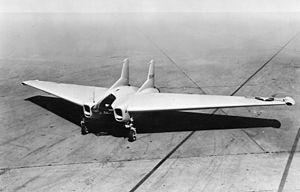5 July 1944 – The first U. S. rocket-powered military aircraft, the MX-324, flies at Harper Dry Lake, California. The pilot, Harry Crosby, makes the voyage. Crosby was later killed in a test flight in a later version of the aircraft.
 In 1942, John K. (Jack) Northrop conceived the XP-79 as a high-speed rocket-powered flying-wing fighter aircraft. In January 1943, a contract for two prototypes (s/n 43-52437 & 43-52438) with designation XP-79 was issued by the United States Army Air Forces (USAAF).
In 1942, John K. (Jack) Northrop conceived the XP-79 as a high-speed rocket-powered flying-wing fighter aircraft. In January 1943, a contract for two prototypes (s/n 43-52437 & 43-52438) with designation XP-79 was issued by the United States Army Air Forces (USAAF).
To test the radical design, Northrop was given a contract to build three glider demonstrators, to designs from the Engineering Division of the USAAF Materiel Division.[citation needed] Given the Northrop designation NS-12, the three gliders were also given project numbers from the USAAF. Confusingly, two project numbers were used, one MX-324 when discussing secret aspects of the powered gliders, and another, MX-334, relating to the aircraft when being built and flown as pure gliders.[3]
The MX-334 emerged as a flying wing glider with no tail surfaces, similar in layout and construction to the Northrop N-9M. Completed in late Spring 1943 the no.1 MX-334 was tested in NACA Langley’s wind tunnel, after which a large wire-braced fin was added to ensure directional stability at high speeds. The first flight attempts was carried out by the no.2 aircraft towed behind a Cadillac car for low level take-off and landing tests, with no success. After modifications the first launch was carried out on 4 September 1943, towed behind a large truck. For more comprehensive testing, a Lockheed P-38 Lightning was used to tow the aircraft on its first proper flight on 2 October 1943.
In early 1944 the no.2 aircraft was modified to take the 2,009 lbf (8,940 N) Aerojet XCAL-200 rocket motor, reverting to the “secret” MX-324 designation. The aircraft was also fitted with combined rudder and airbrakes outboard of the elevons. Testing with the rocket motor commenced on 22 June 1944, with the first aerotow launch for a powered flight on 5 July 1944, making it the first US-built rocket-powered aircraft to fly.[2] Flight testing was concluded by 1 August 1944 and the two remaining aircraft were disposed of. The no.3 MX-334 was written off on its second flight, on 10 November 1943, after Harry Crosby lost control in the prop-wash of the P-38 tug.
The XP-79B was lost during its first flight on 12 September 1945, following delays due to bursting tires and brake problems on taxiing trials on the Muroc dry lake. While performing a slow roll 15 minutes into the flight, control was lost for unknown reasons. The nose dropped and the roll continued with the aircraft impacting in a vertical spin. Test pilot Harry Crosby attempted to bail out but was struck by the aircraft and fell to his death. Shortly thereafter, the second prototype (43-52438) and the overall project was canceled.
Source: Wikipedia
